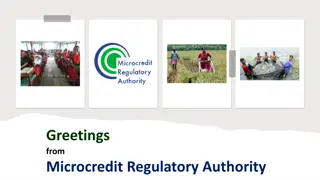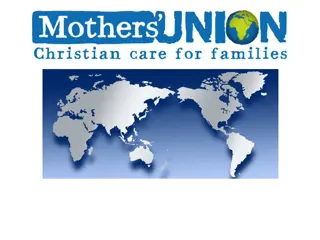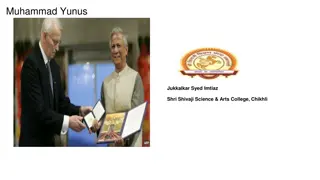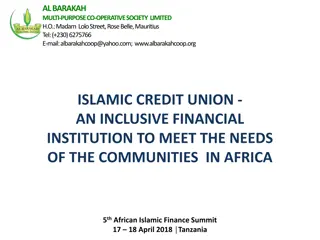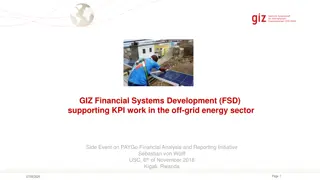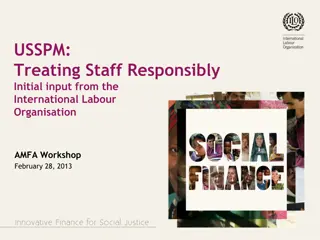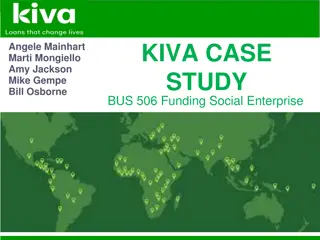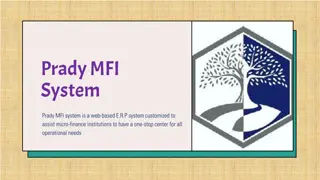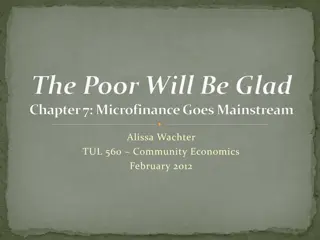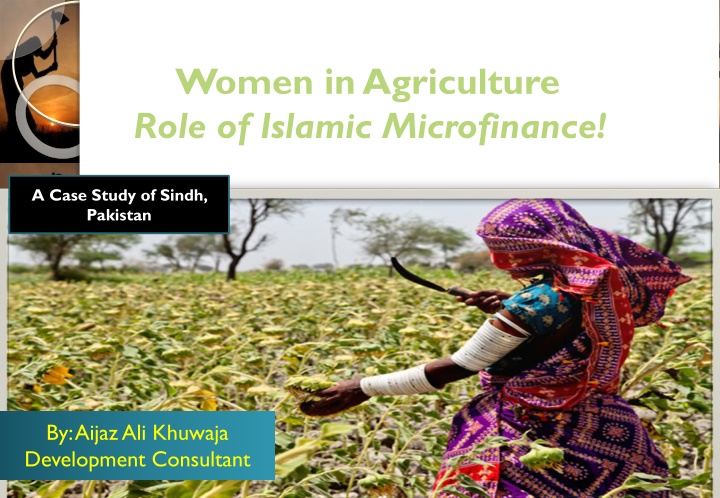
Empowering Women in Agriculture Through Islamic Microfinance: A Case Study in Sindh, Pakistan
Discover the vital role of women in agriculture in Sindh, Pakistan, and the impact of Islamic microfinance on their empowerment. Explore the challenges faced by rural women, their significant contributions to crop production and other activities, and the opportunities for sustainable development in the agricultural sector.
Download Presentation

Please find below an Image/Link to download the presentation.
The content on the website is provided AS IS for your information and personal use only. It may not be sold, licensed, or shared on other websites without obtaining consent from the author. If you encounter any issues during the download, it is possible that the publisher has removed the file from their server.
You are allowed to download the files provided on this website for personal or commercial use, subject to the condition that they are used lawfully. All files are the property of their respective owners.
The content on the website is provided AS IS for your information and personal use only. It may not be sold, licensed, or shared on other websites without obtaining consent from the author.
E N D
Presentation Transcript
Women in Agriculture Role of Islamic Microfinance! A Case Study of Sindh, Pakistan By: Aijaz Ali Khuwaja Development Consultant
Background Sindh is the second largest province of Pakistan in terms of population and economic output. Sindh contributes almost 33 percent of the national Gross Domestic Product (GDP), It covers 18 percent of Pakistan s total landmass Sindh s current population (Census 2017) is around 42.9 million out of 204.7 million Pakistani population The province of Sindh comprises of 29 districts that are further divided on the basis of their geographical position and climatic conditions in to three particular regions: upper, middle and lower Sindh Sindh s agriculture input is around 40% in overall Pakistani agriculture economy Sindh is mainly agriculture based. Its main crops include rice, cotton, wheat, sugarcane, mangoes, and bananas. Sindh is known for the quality and quantity of its cotton production. The province has plenty of natural resources including oil, gas, and coal. Out of total 14 million hectares in Sindh, 5.45 million hectares are cultivable. The remaining area is either hills of Kirther Range, eastern desert of Thar and Achharo Thar, regions.
Women in Agriculture Sector Pakistan s agriculture sector involves 43.7% of labor force that produces their own food needs and ensures availability of food for the rest of nation and value added activities. Men and women farmers are involved in multiple sources of agriculture based livelihoods in Sindh, Pakistan and majority of them are either small subsistence farmers or tenants. Women in Sindh are involved in crop production from sowing to cultivation to market of products Rural poverty ratio in Sindh is around 56% (Women are most vulnerable group) Internal migration from rural to urban areas, especially male, has been increased in last one decade due to less opportunities and land ownership, farming & livelihood issues This has substantially increased the role of women in both on-farm and off-farm activities along with greater work burden and responsibilities of women at home.
Contribution of Women in Agriculture The role of the rural women has not been recognized to the extent they contribute. Their involvement is actually more than men in crop production, livestock and dairy farming They are facing multiple issues due to local social and cultural norms. During last two decades, many people, mostly men migrated from rural to urban areas of Sindh or abroad in order to improve their income possibilities and to avoid exploitation from local landlords. Such conditions have given rural women an active role in on-farm and off-farm activities and has also increased their work burden and responsibilities. Women in rural Sindh work on average for 12-14 hours a day. Rural women play an important part in agriculture sector activities and they are also involved in house activities like clothes washing, childcare and care of elder members of the family.
Contribution of Women in Agriculture Rice and cotton cultivation in Sindh jointly accounts for more than one-third of women s annual agricultural activities. Similarly, women s participation is the highest in cotton production in Sindh as this is considered to be women led activity. In rice and cotton growing areas, rural women have been spending 39 percent and 50 percent of their time in related activities respectively. They are involved in various primary and secondary cotton operations including weeding and thinning, applying manure, hoeing, cotton cleaning, stick removing and storage of cotton seed for domestic use. Women in rural areas also involved in fetching water from 1 to 2 KM away from their houses in rural areas of Sindh Women involved in household activities and care of children
Issues of Womens Involvement in Agriculture Women farmers have less knowledge about using latest agriculture technologies They have increased burden of on-farm and off-farm activities, lack of clean drinking water, Inappropriate sanitation facilities, low and poor quality health services and imbalanced intake of food affects women s health and makes them prone to diseases. Many women during diseases & pregnancies further suffer in the hands of quacks. This has also increased the prevalence of mortality rate amongst rural women Rural Sindh is facing menace of hepatitis A & B, C in many areas. Maternal anemia is very high and 62 percent pregnant women face chronic malnutrition in rural areas of Sindh Nearly 60 percent non pregnant mothers are having low hemoglobin levels. 39 percent mothers (married women of child bearing age) are underweight. Women farmers are facing issues of chemical hazard during use of chemical spray in fields They have not been given training about the use of chemicals in field They have no access to mechanized farm equipment Women perform most of the activities manually and increases their workload. This is affecting women s productivity and wage rate. Women are also having limited access to markets because of a patriarchal society.
Role of Islamic Microfinance in Agriculture Pakistan is one of the most promising markets for Islamic Microfinance, with nearly 98% of the 180 million population being Muslim. ... Although a number of MFIs now offer Shariah compliant financial products in the sector. While Islamic microfinance s reach has increased considerably over the past few years, provision of Sharia-compliant products is still in its early stage, in Pakistan and globally. According to Trends in Sharia-Compliant Financial Inclusion, customers using Sharia-compliant products represent less than 1% of total microfinance outreach in Pakistan. At the same time, the overall demand for Islamic microfinance products seems to be growing rapidly, and Pakistan is set to be one of the most promising markets. Several institutions have launched Islamic microfinance products in Pakistan over the past few years, and there are two microfinance providers that offer a fully Sharia-compliant product line. One of these is Akhuwat, which operates primarily on the disbursement of Qard-Hassan, or interest-free loans offered through donations given by individuals and other organizations supportive of its cause. The delivery model is based on the concept of community, with most branches set up in mosques and churches. The second institution is Wasil Foundation, which offers a variety of Sharia-compliant products incorporating a margin of profit for the institution, including salam (advance against future delivery), istisnaandmurabaha (cost plus mark-up), diminishingmusharaka (profit- and-loss sharing), and ijarah (leasing). According to Pakistan Microfinance Network (PMN), Islamic Microfinance Models and their Viability in Pakistan, highlights the need for funding sources to fill the existing gap in Islamic microfinance provision in Pakistan. The different sources of financing include Waqf and Takaful models, each with their own strengths and weaknesses in terms of viability in the Pakistan context. Islamic microfinance facility do not exist in rural or semi urban areas of Sindh, Pakistan, where mostly agrarian society reside.
Proposed Solution Women in Agriculture Land Reforms in True Sense Land Titling/ownership for Women Microfinance loans for seeds, urea etc Formation of Women Groups Phase B Phase A Microfinance loan in groups Provision of Islamic Micro financing at doorstep Microfinance Scheme Training of women farmers/owners about the safe use of chemicals Phase C Ownership Transfer Consumers Involvement of women in agriculture can prevent world from food crisis!
Kay Constraints of Rural Women in Agriculture Rural women in the agriculture sector do not have access to latest technologies and farming, etc. The reason is weak extension services and illiteracy among women Lack of access to educational and vocational training facilities and weak vocational training infrastructure that limits women s ability to improve their agriculture productivity and income. Disparities in daily wage rates and working hours of women and men. Social barrier and cultural taboos Constraints Women in agriculture need micro financing in education, health, agriculture inputs & capacity building about the use of latest technologies in farming Women in farming must be educated about the use of latest technologies & use of chemicals in agriculture products Address social barriers through mobilization Solutions
Recommendations contribution in agriculture production along with providing them a platform for quality of their manufactured products. Rural women promotional activities should be started in rural Sindh on a public private partnership basis with the aim of creating awareness regarding rural women s Improve their technical knowledge in agriculture production and management. gain knowledge and awareness on new techniques that they can use for crop and Agriculture extension training programs need to be conducted at the Union Council or village level rather than in towns and cities. This will help rural women Government and private sector should facilitate women in all agriculture related activities Women should be made aware and empowered on how to get a better price of their agriculture, livestock, poultry, forestry, embroidery and other handmade products. Government should develop and implement a regulatory framework that provides support in agriculture sector. Land reforms are required and there is need of proper share of women in land ownership Islamic microfinance banking system required at village/union council level to support women in farming at their doorstep

